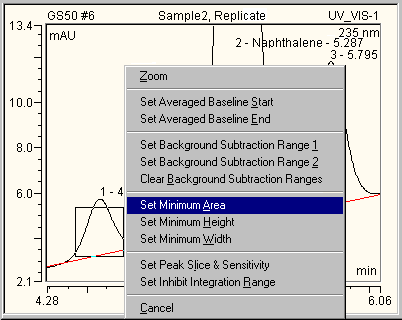Defining Detection Parameters
![]() Reducing the Number of Evaluated Peaks
Reducing the Number of Evaluated Peaks
To limit the integration report to a manageable size, only the most important peaks (i.e., the largest peaks) should be included in the evaluation. Define either the Minimum Height or the Minimum Area.
![]() Tip:
Tip:
If you simply want to make the report clearer, you can hide certain unwanted peaks; see also ![]() Hiding Unwanted Peaks in the Report.
Hiding Unwanted Peaks in the Report.
To define a minimum area/height for evaluated peaks
The following example refers to the minimum peak height:
On the File menu, click Open and select a QNT File.
Click on the Detection tab page.
Look at the chromatogram and determine the minimum peak height to be evaluated. You may also click the smallest peak to be integrated. Right-click on the peak and select Peak Properties.... The dialog box displays the width, height, and area of the peak.
In the Parameter Name column of the quantification method, select the name of the parameter to modify; for example, Minimum Height.
In the Parameter Value column, type the smallest possible signal value, for example, in mAU, as the new parameter value.
In the Ret. Time column, type the time (relative to injection time) from which the parameter becomes valid.
![]() Tip:
Tip:
Instead of typing the parameter name, value, and time directly in the table, press F8 to open the Edit detection parameter dialog box where you can the three together.
All peaks with a height lower than the indicated value will not be displayed. As the parameters affect peak recognition and thus the baseline, you must consider a tolerance of approximately 5% to ensure that all peaks of interest are recognized.
To graphically define a minimum area/height for evaluated peaks in the chromatogram
In the chromatogram, find the smallest peak just no longer to be displayed.
Enlarge this peak to be clearly visible.
In the chromatogram, right-click to select an area whose area is a slightly smaller than that of the selected peak.
Select Set Minimum Area on the context menu. The selected area is entered as the minimum area together with the time of its left edge into the QNT Method.

In the Ret. Time column, type 0.000 as time or move the parameter in the chromatogram with the Detection Parameter Tool so that the minimum area is valid for the entire chromatogram.
![]() Note:
Note:
You can undo the graphical input of detection parameters. Click one of the tables of the QNT Editor and select Undo on the Edit menu. (In the chromatogram itself, you can only undo the modifications of the currently open chromatogram.)